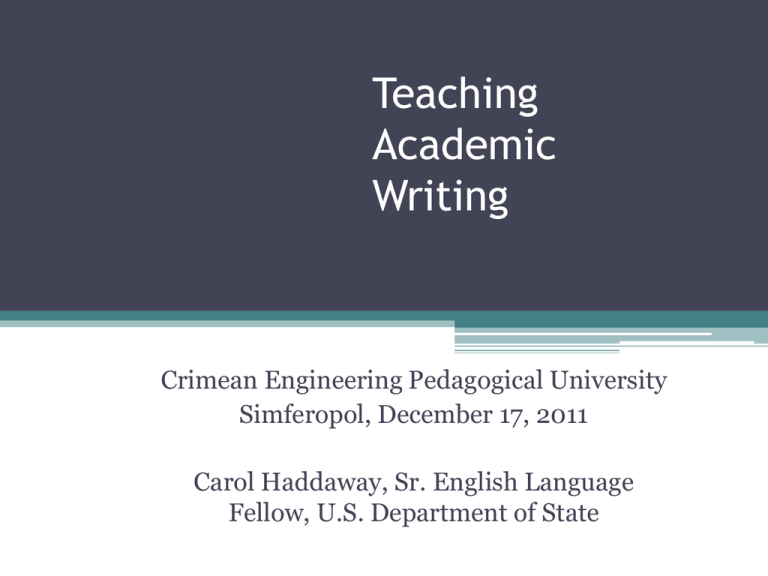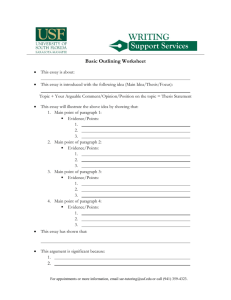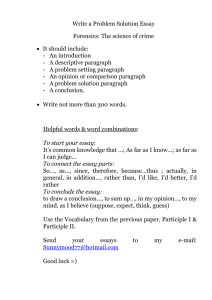
Teaching
Academic
Writing
Crimean Engineering Pedagogical University
Simferopol, December 17, 2011
Carol Haddaway, Sr. English Language
Fellow, U.S. Department of State
“Rewriting is the essence of
writing.”
(Zinsser,
1998)
WHAT MAKES GOOD WRITING?
WHAT MAKES WRITING GOOD?
Outline
•
•
•
•
•
Writing as a process of discovery
Composing and generating ideas
Organization
Feedback and revision
Good writing
Think about your question individually (1)
Pair with a partner and discuss (2)
Share with another pair (4)
Choose a spokesperson to share your question with the whole
group/class
Warm up discussion questions
• Writing is usually thought to be the most difficult skill to
acquire and should only be taught after students have learned
the other skills. Do you agree? Explain
• Writing is a matter of putting together strings of
grammatically correct sentences. Do you agree with this
statement?
• Reflect on your experience as a second/foreign language
learner. Did you have problems in generating/expressing your
ideas in writing? What were those problems? How did you
deal with those problems?
• What approach do your use in teaching writing skills? How
successful have you been in teaching writing?
• How do you respond and give feedback to students’ writing?
What criteria do you use?
• How is writing like swimming?
How is writing like swimming?
• Psycholinguist Eric Lennenberg (1996) noted
that human beings universally learn to walk and
to talk but that swimming and writing are
culturally specific, learned behaviors. We learn
to swim if there is a body of water available and
usually only if someone teachers us. We learn to
write if we are members of a literate society, and
usually only if someone teaches us. (Brown,
2007, p. 390)
Writing as a Process of Discovery
• Meaning created through the process of
writing recognizes the importance of
▫ Generating ideas
▫ Formulating and organizing ideas
▫ Refining or revising one’s ideas
• Revision and feedback then become the
main focus of instruction
(Zamel, 1987)
Composing versus writing
• The act of writing itself, pre-writing and
rewriting are all interdependent, interact
together and repeatedly in order to discover
meaning.
• Writing and rewriting is a continuing attempt
to discover one’s intended meaning (Zamel,
1987).
• The process of writing gives students a
chance to think as they write.
• Writing is indeed a thinking process.
The Composing Process
• Written products are often the result of
thinking, drafting, and revising procedures
• Generate ideas
• Coherence (flow of ideas)/cohesion – use of
subordination, coordination, transition
signals, discourse markers, references “wave
theory” (handout)
• Revise text for clearer meaning
• Edit text for appropriate grammar
(Brown, 2007).
Revised version (coherence)
• I am taking an engineering course in Advanced
Dynamics, an ESL course, a seminar, and
research. Although it is 12 units in total, it is a
light load for me. I only pay attention to
dynamics and English, but because this is my
first semester, it is most important for me to
improve my English.
Topics (authenticity)
• Consider how writers feel about the
topics they are asked to write about
• Will they engage the students’ interest?
• Is the content relevant and engaging?
• – writers write both quantitatively
more and qualitatively better when
they are composing papers about topics
that engage them, subjects they are
involved in including academic topics.
(Perl
in Zamel, 1987)
Generating ideas
Generating ideas is a ‘messy and chaotic
process’ (Raimes, 2002)
Students need to be taught how to explore
ideas and topics to write about, develop ideas,
and discover relationships
Methods for generating ideas
classroom discussion
brainstorming, clustering
free writing, listing, outlining
Wh- questions
Brainstorming Bubbl.us Tutorial
14
Clustering
Ask primary Wh-questions
•
•
•
•
•
•
What?
Who?
Where?
When?
How?
Why
Writing Prompt
• Essay topic: Second language writers have the
dual task of learning English and learning to
write in English. What are the biggest challenges
you face in teaching writing in your class? Why
is it important to teach writing and what
strategies would be most helpful to nurture good
writing? Wherever possible, connect your main
points to your own teaching situation and give
examples to support your point of view
Brainstorm Writing prompts
Answer the questions/follow
directions
Make sure you read the essay prompt
carefully.
• Make sure to address each point from the
prompt.
• Observe the word/page limits.
Organization
• Be Organized!
• Open your essay with an
introductory paragraph that draws
in the reader, and close it with a
concluding paragraph that leaves the
reader with a lasting thought or
image about you.
The Paragraph
• Build your essay with cohesive paragraphs
• Each paragraph covers one main idea.
• Paragraphs should begin with a topic
sentence or main idea that will interest the
reader and give an idea of what the
paragraph is about.
• Support the topic sentence with logical points,
details, evidence, examples, a quote.
• End the paragraph with a concluding
sentence.
• Remember to use transitions and connectors
to help your ideas flow smoothly.
(Analyze: different stages of friendship)
Essay Organization
• Introduction paragraph (general)
▫ Thesis statement
• Body paragraphs (more specific)
▫
▫
▫
▫
Topic sentence
Ideas, opinions
Examples
Quotations
• Conclusion paragraph (summary)
• Effective use of transition words and
phrases, logical connectors
Review essay
Types of feedback
•
•
•
•
•
•
•
•
•
Evaluate with a grade
Locate and correct student’s errors
Make suggestions for change
Reflect and subtly correct
Rewrite passages
Comment on strategies - define
Ask questions
Emote, criticize, describe
Praise (less frequently)
(Raimes in Richards and Renandya 2002)
Teachers can help students re-vise
• By becoming the audience
▫ “I have a question about X here.”
• By becoming a reader
▫ “When I read this paragraph, I felt….
• By acting as a writing consultant
▫ “This paragraph needs more detail; try a pre-writing
strategy to collect more information.”
• By becoming a describer
▫ “Your thesis statement indicates that you will discuss
X, but in the second paragraph you talk about Y…why?
Revising text
• Based on self/peer/teacher feedback
• To improve global content and the
organization of ideas so that the
writer’s intent is made clearer to the
reader.
• For a coherent, logical essay, deleting,
adding, and moving paragraphs,
sentences, words are part of the
revision process
Example
• Draft: The onset of alcoholism has
been classified into four stages. There
is the Pre-alcoholic stage, the Early
alcoholic stage, the Crucial stage, and
the Final stage.
• Revision: Alcoholism progresses in
four stages: Pre-alcoholic, Early
Alcoholic, Crucial, and Final.
Editing
• Editing and proofreading should focus
on syntax, grammar, language forms,
vocabulary, mechanics, format, etc. and
are means by which to better express
one’s meaning
• Grammar-based approaches to
teaching writing may have little to do
with composing
TRIP Criteria for Readable Writing
T - What is the topic, thesis, main idea, focus?
R - How is one idea related to others?
I - What is most important?
P - What is the precise meaning?
(Walvoord, 2009)
Review essay again – holistic
t
Intellectual Integrity
• Be honest.
• Do not plagiarize.
• Do not misrepresent your language
ability.
What is good writing?
• Arabic
▫ it’s all adjectives… decorative, ornate, full of
courtesy & deference, intentionally pleasing
▫ It’s all proverbs… “What you are seeking is
also seeking you.”
• Spanish
▫ long sentences and melodious long nouns
that express a general idea, rich in feeling
but no action.
• Russian/Ukranian?
Academic Writing Style in English
• Clear and concise
• Direct – writer gets to the main point
as quickly as possible
• “Linear” in development – writer
makes a point and immediately
supports that point with evidence
• Formal in its use of vocabulary and
sentence structure
Lane and Lang (1999)
Good writing
• Is one of the hardest things people do
• May not be taught, but can be learned.
“Because writing is individual and
personal, it is difficult to teach. I am
often asked what makes a good writer.
The better question to ask is what
makes good writing?”
(Six Traits of Good Writing)
(http://educationnorthwest.org/resource/514)
Online Writing Applications
Brainstorming/Organizing: Bubbl.us
◦ http://www.bubbl.us/edit.php
Composing/Collaborative Writing: Writeboard
◦ www.writeboard.com
Peer-/Self-Editing: Rubistar
◦ http://rubistar.4teachers.org/index.php
◦ eWriting: ESL Writing Success
◦ http://flang1.kendall.mdc.edu/curric.htm
34
References
• Brown, H.D. (2007). Teaching by Principles. Pearson
Longman.
• Farrell, T. (2006). Succeeding with English Language
Learners. CA: Corwin Press.
• Lane, J. & Lange, E. (1999) Writing Clearly An Editing
Guide Second Edition. Heinle & Heinle.
• Raimes, A. (2002). Ten Steps in Planning a Writing
Course and Training Teachers of Writing. In J.C.
Richards and W. A. Renandya (eds), Methodology in
Language Teaching. Cambridge University Press. (p.
306-314)
• Smalzer, W.R. (2005). Write to be Read. Cambridge
• Walvoord, B.E., (2009). Establishing Criteria for
Student Writing in all Disciplines (workshop handout)
References
• White, R.V. (1987). Approaches to Writing. In
M.J., Long and J.C. Richards (eds.), Methodology
in TESOL. Heinle & Heinle. (p. 259-266).
• Yakhontova, T.V. (2002). English Academic
Writing.
• Zamel, V. (1987). Writing: The Process of
Discovering Meaning. In M.J., Long and J.C.
Richards (eds.), Methodology in TESOL. Heinle &
Heinle. (p.267-278).
• Zinsser, W. (2009, August 11). Writing English as
a Second Language. Retrieved from
http://www/theamericanscholar.org/writingenglish-as-a-second-language







